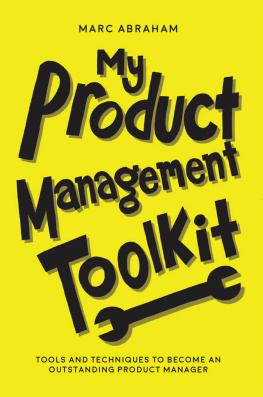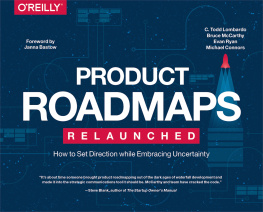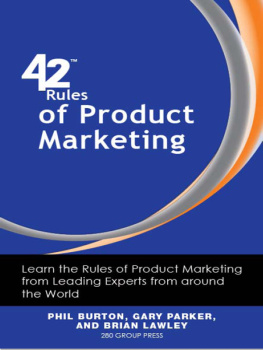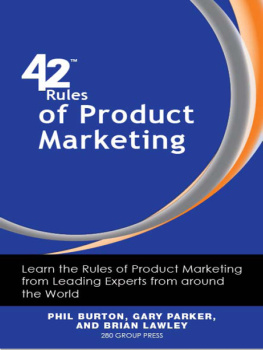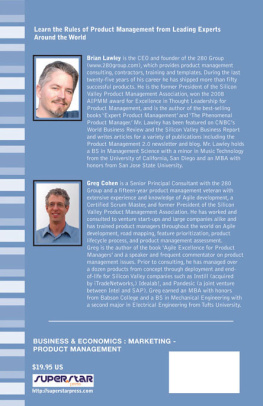The Product Marketing Manager
Responsibilities and Best Practices in a Technology Company
Lucas Weber
About the Author
Lucas Weber began his career as a Software Product Manager until finding his calling as a Software Product Marketing Manager, which utilizes his talents for communicating development tech talk into marketing and sales messaging and for positioning a product for success in companies of all sizes.
Table of Contents
Introduction
What will you be doing here? asked my new colleague during my first week at a small company I had recently joined as its very first Product Marketing Manager (PMM). He was a developer and explained that, to his understanding, everyone who worked in marketing was there to market the companys products so why would someone be hired with a redundant title like mine? What would I be doing for this company that wasnt already being done?
Having faced this same situation at multiple companies in the past, I had a ready answer: Defining the positioning and messaging of our products as well as planning and executing product releases and launches.
Although he seemed somewhat satisfied with my answer, I had the feeling that he still didnt clearly understand the role of a PMM. Could I blame him? That one sentence could never explain all of the intricacies of the role.
I decided to search online for a book that best explained the role. To my surprise, I was not able to find what I was looking for. Sure, there were a few books that touched briefly on the subject or offered quotes from successful professionals who had worked in the role, but nothing that succinctly and clearly tied everything together and was also entertaining to read. That quest is what led to the creation of this book.
Before we jump into it, I should begin by explaining a bit about myself and my experience in the role. My background is in software product management: helping to create and deliver the best possible products and sustainable revenue growth as a Product Manager (PM). While I was successful and happy in this field (advancing from PM to Director of Product Management with my own team of PMs), I noticed over the years that my most valuable talent was actually in product positioning and messaging.
When it came to understanding a product on the technical level and then turning that detailed information into key marketing and sales messages by defining a unique selling proposition and differentiation from competition, I was suddenly enjoying my daily work more than ever before.
I left product management to join another company as a Senior PMM. No longer was I working in teams of programmers and PMs but was now fully immersed in a marketing team. This new group had its own terminology, perspectives, tasks, and workflows, much of which was new to me.
I briefly searched for a book about the PMM role when I made this switch. However, I must have been rather caught up in learning-by-doing because the desire for a good book on the subject was soon forgotten amidst other topics.
Since that time, I have spent many years thoroughly enjoying the PMM role and working alongside others similar to me, be they colleagues of mine or people from other companies whom I have interviewed for their insights or worked alongside in different projects.
I have also witnessed numerous times that there is no clear path to becoming a PMM. There are no standardized lessons, classes, or degrees that would be universally recognized and accepted. This is because the role and responsibilities of the PMM varies from professional to professional and from company to company. The path to product marketing can have many beginnings and PMMs come from different educational backgrounds and experiences. Perhaps you studied Computer Science, Literature, History, Economics, or received your degree in Business Administration. You may have come from working in Product or Project Management, Marketing Communications, Programming, Sales, or any number of other roles. What is important is that you arrived at product marketing because it is what inspires and drives you and because you add the most value to your organization in that particular role. If you are still considering if this role is right for you, this book will help you decide.
While it touches upon a wide range of topics, this book focuses solely upon those topics from a PMMs perspective and defines them as part of the role. There may be many tasks and responsibilities in this book that speak directly to you and yet there may be some that you choose to ignore as they are not relevant to you or your company at this time. Part of the pleasure of being a PMM is defining and adapting the role to match your personal strengths as well as aligning it with your companys needs.
As part of my pursuit of excellence and desire to learn more about the role, I have attended numerous presentations about the subject and completed the most popular and useful training courses and certifications available. While these courses are valuable and highly recommended, they tend to focus on what the role means on a conceptual level but not what is required of it on a more practical level. This book closes that gap and provides practical examples of everyday situations and tasks associated with the role of the PMM to further your understanding of how to apply what you know.
I have drawn upon my personal experiences to illustrate this book, but have also incorporated experiences, anecdotes, and feedback from other professionals I have worked with. My hope is that this book provides insights into this wonderful role and that every reader comes away with a better understanding of, and desire to become proficient in, Product Marketing.
Chapter 1: The Hybrid Role
The Communicator
There is an often-cited quote that states that regardless of what job you have, your ultimate success will be based upon your academic credentials (5%), your professional experiences (15%), and your communication skills (80%).
It could be easily argued that for a PMM, the balance is even more heavily weighted towards communication. A good PMM needs to embrace communication as the key to obtaining the best results both internally within their company and externally. This includes controlling the incoming and outgoing flow of information, how it is filtered and captured, organized, and communicated further.
When it comes to the intake of information, being a PMM means conducting constant research and absorbing the most relevant and important data. As we delve deeper into how the PMM interacts with different business units within the company, and ultimately how successful product positioning and messaging is accomplished, we will see that one must keep alert at all times. Examples include attending industry events, meeting prospects and customers, conducting surveys, and tapping into social media.
It may begin to seem like an impossible amount of data that the PMM must gather and an equally impossible amount of tasks to complete and meetings to attend. Just like any role in an organization, we cannot accomplish everything at once but we can identify where we can make the greatest impact at any given time and what data will help get us there. Good prioritization skills and management of ones time and focus is the solution. Even though PMMs work with many business units simultaneously, we must often prioritize which meetings and projects we have time for and which can be handled by other people who can relay the most relevant information to us at a later time.
I have often found myself overwhelmed with data but the solution is quite simple: Which of that data do you currently need right now and what can wait for later (or never)? A PMM must gather as much information as possible and then filter out what is not relevant. Some of that filtered information may be useful later but are you equipped to handle it at this moment and is it relevant to the tasks at hand? Filtering also means accepting different (sometimes exceptionally different) perspectives and messages from different stakeholders and assimilating them into a greater understanding.
Next page

